Beyond the Darkness (1979)
Directed by: Joe D'Amato
Written by: Giacomo Guerrini, Ottavio Fabbri
Starring: Cinzia Monreale, Franca Stoppi, Kieran Canter, Sam Modesto
AKA BUIO OMEGA [DARK OMEGA], IN QUELLA CASA BUIO OMEGA [HOUSE OF THE DARK OMEGA], BURIED ALIVE, BLUE HOLOCAUST
ITALY
AVAILABLE ON BLU-RAY AND DVD
RUNNING TIME: 90 mins
REVIEWED BY: Dr Lenera
Francesco, a rich young orphan, loses his fiancée Anna to voodoo doll mischief on the part of his housekeeper Iris who’s jealous of his attentions. He digs the dead woman up, cleans her out, stuffs her, and puts her in bed at the mansion. However, this doesn’t stop him being attracted to other women, though, seeing as he’s getting progressively more insane, he also has trouble fighting the urge to kill them. As for the love struck Iris, she seems happy to help – for now….and could Anna have had a sister?….
Chatting to some of my HCF colleagues about erotic cinema not long ago brought up the name of Joe D’ Amato, a guy who worked in most genres and made a total of – wait for it – 196 movies, though is probably best known for the ‘video nasties’ The Anthropophagous Beast and Absurd, even though he was most prolific in soft core [and even did some hard core]. I vaguely remember seeing a few of the sex movies many years ago though have had little desire to see them again, and recall that the two ‘nasties’ just aren’t very good at all. However, Beyond The Darkness is considered by Joe [well, his real name is Aristide Massaccesi] to be his best film, and after watching and reviewing several subtle, bloodless horror movies, I fancied some grue. Well, even though the stuff you sometimes read about it containing onscreen necrophilia is false [Nekromantic this is not, and frankly I was quite pleased about that], this is one still sick, grisly movie for 1979, D’ Amato obviously seeing how far he could push things, but what surprised me even more is that it’s also a fairly well made effort. Now that’s not to say that it’s a quality product through and through. One of the last of a line of Italian Gothic films featuring a particular kind of protagonist and situation which began with The Horrible Dr Hitchcock in 1962, it lacks much atmosphere – though you could say that it does feel very grimy and sleazy which is an achievement if not a particularly pleasant one – its plot sort of peters out towards the end just when it seems to be ramping up and getting really interesting, and Kieran Canter is just plain inadequate in the lead role. But there are definitely compensations.
This is actually a remake of 1965’s The Third Eye, which claimed to be based on Gilles de Rais, the medieval baron who fought alongside Joan of Arc, then supposedly killed hundreds of children, though actually bares little resemblance to his doings. It did, though, run into trouble with the Italian censors, who initially rejected it. It was that film’s director and co-writer Mino Guerrini’s son Giacomo who wrote the screenplay for Beyond The Darkness. Franca Stoppi, who played Iris, signed on to replace another actress without even reading the script beforehand. D’ Amato said in an interview, “I personally opted for the most unrestrained gore, since I don’t consider myself very skillful at creating suspense”, and, according to actress Stoppi, said on set, “We’re making a movie to make people throw up. We must make ’em vomit!”. Rumours persisted for some time that he used a real corpse for one scene; he eventually debunked this. The Italian censors again weren’t too happy and demanded cuts to scenes of embalming and dismemberment, while box office wasn’t very good, though the film was re-released in Italy in 1987 under the title In quella casa buio omega [House Of The Dark Omega] so it seemed like part of the la casa series which consisted of, believe it or not, the first two Evil Dead films, Ghosthouse and its two sequels Witchery and, confusingly, Beyond Darkness, plus House 2 and 3, all retitled la casa 1 to 6! Meanwhile the US version under the title Buried Alive lost three minutes of Frank picking up a girl in a disco and the undertaker trying to spy on Frank. It never got as far as a cinema or video release in the UK; it would have probably been banned.
The viewpoint of a person driving a van along a winding country roads is the first thing that we see, and I’m still a bit confused about the next scene in which Francesco and a helper are moving things out of a house. I guess it’s the house of his fiancee Anna, but it certainly isn’t clear. Anna is now in hospital because Iris is using voodoo to make her ill. Iris wants to marry Francesco and be co-owner of his lavish mansion in the process. A zoom in to a pendant being worn by Anna reveals two twin children, obvious foreshadowing of something that will happen later. Anna seems to know that she’s about to die soon, telling a nurse to make her look healthy, after which Francesco turns up. The two kiss, and she dies quite contentedly. It’s really quite a moving scene, and it’s followed by another one when Francesco sits in his mother’s room, both his parents having died in a car crash five years ago, and gazes at a photo of his mother while the camera slowly zooms into first her picture and then his face being reflected in a mirror beside the photo, both scenes accompanied by a rather beautiful melancholic piano piece from Goblin. Frankly by now I was most surprised that, not only was D’ Amato’s cinematography [billed doing it under his real name] attempting some artistry, but also that I was feeling some genuine emotional involvement from a D’ Amato film, though this was soon replaced by – well, I don’t know what I really felt – the sight of Francesco sucking milk from one of Iris’s breasts. Obviously we’re being told that Francesco has a mother fixation, much like many other psychopaths who followed in the footsteps of Norman Bates, though this element virtually disappears soon after and has little effect on his other doings, so its inclusion was solely to provide yet another dodgy thrill or two in a film full of them. Francesco soon digs up Anna and takes her back to the house, also picking up a hitchhiker along the way, though why on earth he leaves her asleep in his van when he gets to his house I don’t know.
With calm detachment plus a feeling of authenticity, both of which combine to give a documentary-like feel, we watch as Francesco cuts open his fiancee’s stomach, removes the organs, inserts tubes up her nose, uses a syringe to pump out her blood, and replaces her eyeballs. However, embalmers don’t tend to kiss, then bite into, the heart in an addition, replete with blood oozing out of the side, that sorely grossed out many viewers at the time. Of course the hitchhiker wakes up to see what Francesco is up to, and Francesco could have just suffocated her, but before he does so he takes the time to lop off her fingernails just because there wasn’t enough grisly stuff going on. Then Iris takes over and dismembers the body, throwing the parts in an acid bath. The camera adopts a point of view that obscures some of this, but it’s still strong meat [sorry] and, because the camera doesn’t cut, it again almost feels like we’re watching it for real – well, any offal you see in this film is real anyway, being material that came from the local butcher’s. And then, in the bit which actually made Yours Truly want to vomit, we’re treated to close-ups of Iris eating revolting-looking stew interspersed with cuts to the dissolved body parts. One can sense D’Amato and Guerrini thinking up ways to disgust with childlike glee, and I have to admit I rather liked it. There’s also a slight vein of black comedy throughout that occasionally comes to the fore with moments like when Anna’s body is shaking about in the back of the van and one of her arms pops through to one of the front seats, a scene made unintentionally funnier by Francesco turning the steering wheel frantically yet whenever we see the road it’s straight! A dinner table scene with Iris’s relatives, who include a man taking his false teeth out and a moustached woman, is more funny peculiar but I laughed anyway.
So Francesco is obsessed with Anna, and we see him kiss her on the lips onscreen for quite some time, but whether he does actually have sex with the corpse isn’t really stated. Whatever, it clearly doesn’t quite do it for him sexually [well fancy that], because he goes out and looks for other women to pick up despite supposedly being still crazy about Anna. This is done very easily seeing as this film takes place in a world where, after a line or two about how hot it is inside a bar, you can then move straight onto suggesting that you and the woman you’ve just met go for a drive and she accepts immediately. One scene has him recreate Lisa And The Devil’s ‘having sex with one woman while the body of another is beside” sequence, but what Mario Bava made morbidly romantic D’Amato just makes disgusting – but that’s okay as that’s chiefly what Beyond The Darkness is attempting to do in the first place. There’s a modicum of tension provided by a mortuary attendant seeing Francesco doing something suspicious, leading to an investigation, and one genuinely good moment of fear when lights go out when a character is in a room. A strange appearance by an old lady muttering of doom is quite eerie, and there’s also a cheeky moment when Francesco drives off with a girl and we cut to her looking drowned in his bath – only to then see that she’s well and truly alive. But things do go downhill in the final third, despite more nasty delights such as someone being incinerated while they’re still alive and an eye gouging. The arrival of Anna’s sister Teodora on the scene leads us to expect the story to go to some different places, maybe get a little twisty; sadly it fails to really do either of these things, and by the time we end with a really lame ‘scare’, one really wishes that another writer had done some major work here.
Of course one has come to definitely not expect a sensitive study of mania from a film like this, though others do often manage to give their killers character traits in addition to just being very unhinged. One can of course put the inconsistency of much of Francesco’s actions to just being loopy, though it’s always a lazy get out clause. We do get two nutters for the price of one here. Unfortunately Keiron Canter just doesn’t seem to get into the role of Francesco at all, he barely seems to be trying, with the result that one is neither frightened of him, nor feel much sympathy for him in a film which, when it comes down to it, is about the difficulties of letting go. We feel more for Iris, who lets the man she’s in love with bring girls home and do whatever it is he does with his dead wife, and helps him clean up after himself, while she patiently waits for him to return her love. This is despite Franca Stoppi always sporting one of a variety of menacing expressions. Then there’s Goblin’s score, which at times has the volume turned up on it so it’s almost deafening. And that’s all for the best I suppose, seeing as I’m a fan, though there are times when the music doesn’t quite fit, being too upbeat or propulsive, though I guess it does help speed up the pace of a film that might otherwise drag. The tracks aren’t as instantly catchy as the ones that pepper the likes of Deep Red or Dawn Of The Dead, but the band were clearly going for a moodier approach; more emphasise on electronic arpeggios and simple four chord harmonies than prog jazz-rock, though there’s still some of the latter. I’d heard some of the tracks before, as they’d been re-used in Contamination and Zombie Creeping Flesh aka Hell Of The Living Dead. Beyond The Darkness, a film that could have been some sort of transgressive classic, doesn’t entirely work. But it undoubtedly has a morbid fascination, and I think it’s a film which more lovers of the messed-up and the gruesome need to see.

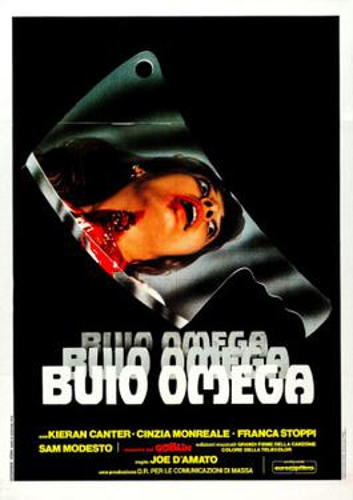
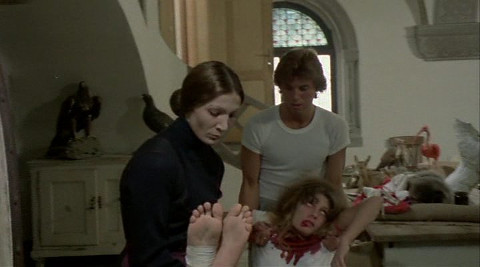
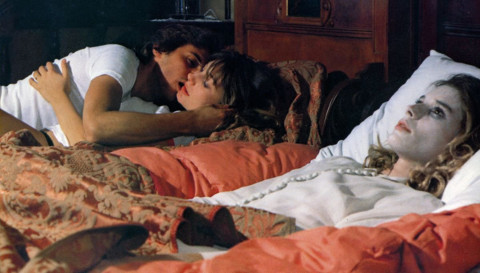




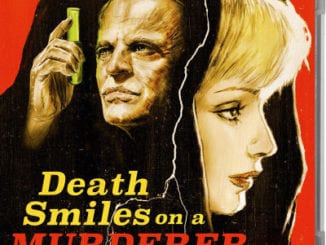

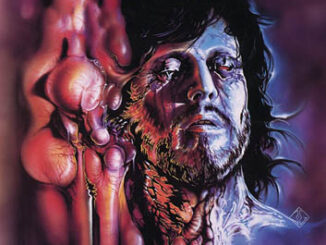
Be the first to comment